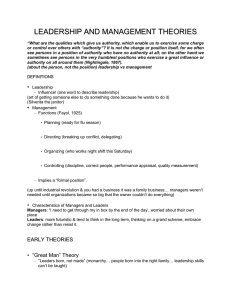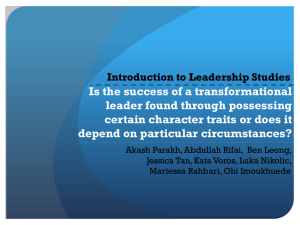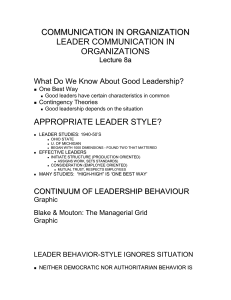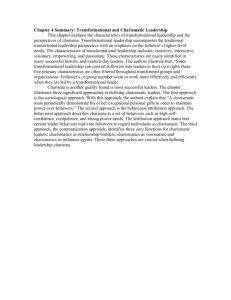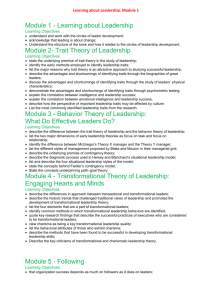Leadership - a very brief introduction
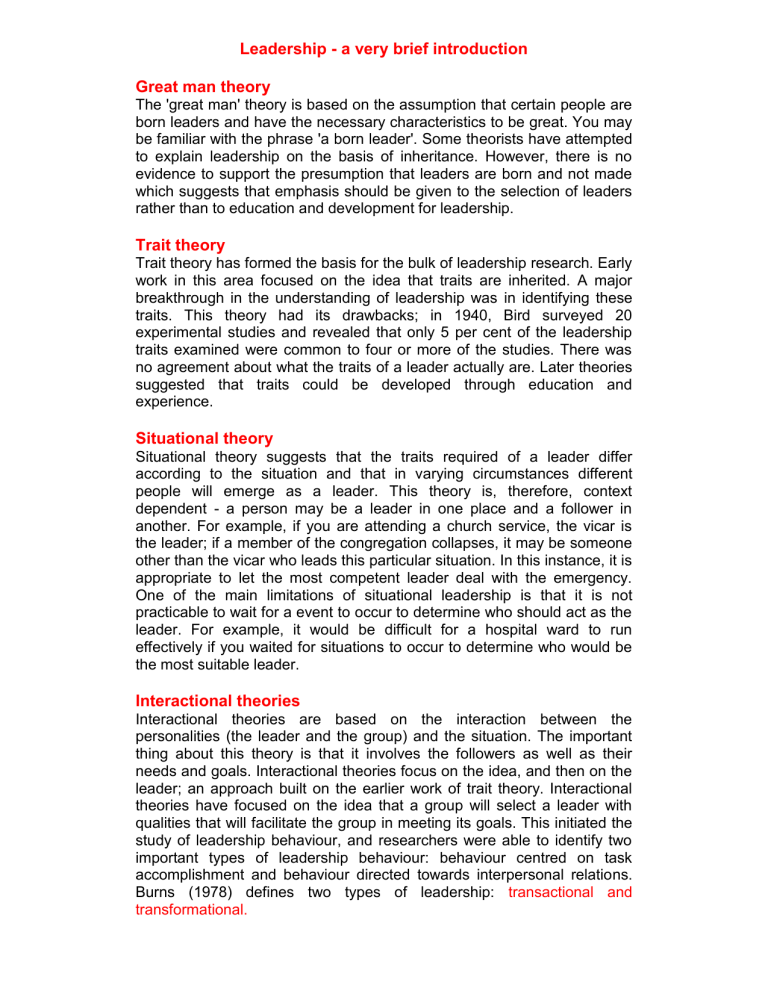
Leadership - a very brief introduction
Great man theory
The 'great man' theory is based on the assumption that certain people are born leaders and have the necessary characteristics to be great. You may be familiar with the phrase 'a born leader'. Some theorists have attempted to explain leadership on the basis of inheritance. However, there is no evidence to support the presumption that leaders are born and not made which suggests that emphasis should be given to the selection of leaders rather than to education and development for leadership.
Trait theory
Trait theory has formed the basis for the bulk of leadership research. Early work in this area focused on the idea that traits are inherited. A major breakthrough in the understanding of leadership was in identifying these traits. This theory had its drawbacks; in 1940, Bird surveyed 20 experimental studies and revealed that only 5 per cent of the leadership traits examined were common to four or more of the studies. There was no agreement about what the traits of a leader actually are. Later theories suggested that traits could be developed through education and experience.
Situational theory
Situational theory suggests that the traits required of a leader differ according to the situation and that in varying circumstances different people will emerge as a leader. This theory is, therefore, context dependent - a person may be a leader in one place and a follower in another. For example, if you are attending a church service, the vicar is the leader; if a member of the congregation collapses, it may be someone other than the vicar who leads this particular situation. In this instance, it is appropriate to let the most competent leader deal with the emergency.
One of the main limitations of situational leadership is that it is not practicable to wait for a event to occur to determine who should act as the leader. For example, it would be difficult for a hospital ward to run effectively if you waited for situations to occur to determine who would be the most suitable leader.
Interactional theories
Interactional theories are based on the interaction between the personalities (the leader and the group) and the situation. The important thing about this theory is that it involves the followers as well as their needs and goals. Interactional theories focus on the idea, and then on the leader; an approach built on the earlier work of trait theory. Interactional theories have focused on the idea that a group will select a leader with qualities that will facilitate the group in meeting its goals. This initiated the study of leadership behaviour, and researchers were able to identify two important types of leadership behaviour: behaviour centred on task accomplishment and behaviour directed towards interpersonal relations.
Burns (1978) defines two types of leadership: transactional and transformational.
Transactional leadership occurs 'when one person takes the initiative in making contact with others for the exchange of valued things that may be economic, psychological, or political'. It is a bargain or contract that is based on the individual differences of both the follower and leader. The exchange of a salary for services or the provision of care is an example of transactional leadership.
In contrast, with transformational leadership the leader and follower have the same purpose. Transformational leadership occurs 'when one or more persons engage with others in such a way that leaders and followers raise one another to higher levels of motivation and morality'.
Transformational leadership implies change in which the leader and follower are united in a collective purpose.
Bass (1990) divides transactional leadership into three categories: laissezfaire, contingent reward, and management by exception. He divides transformational leadership into four categories: charisma, inspiration, individualised consideration and intellectual stimulation.
It is apparent from the summaries of the different leadership theories, that a more integrative, person-centred approach is emerging. The main aspects that need to be considered when choosing a style of leadership include: the leaders, the followers and the work context. Less emphasis is being placed on the leader. Leadership theory has progressed from attempts to identify the inborn traits of leaders, to the study of roles and behaviours of leaders, to the exploration of the situation, work tasks and followers. So the leader being seen as the most dominant member of a group or organisation has become less crucial, and more attention is being placed on the follower and the distribution of power.
One of the advantages of transformational leadership is that it sees the followers as being equally important as the leader. Burns discusses the relationship between leadership and power-both involve motivation, resources and influence. Power is exercised when the leader influences the followers' behaviour to meet the leader's motives, and can be linked to coercion and control. Leadership occurs when the leader acts to satisfy the motives and needs of followers. Power exerted in transformational leadership relates to the need to promote and support a purpose in the best interest of both the followers and leaders. The communication mechanisms that exist between the leader and follower are also important for the success of this relationship. The transformational leader is concerned with the development of his or her followers. The leader will be aware of the strengths and weaknesses of individual followers, thus enabling him or her to plan effectively how followers will perform within their capabilities.
_________________

